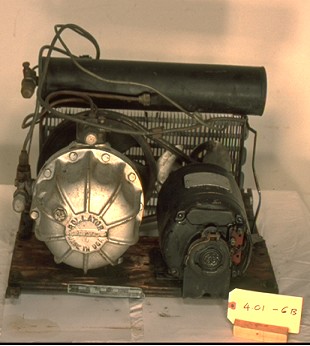Refrigerating and Air Conditioning Condensing Units – Household
As in the case of #034 this is a “high tech” refrigerating machine of the mid 1930’s, a precursor of profound change in the technology offerings of the Canadian refrigeration industry. It was a whole new design concept, by a new generation of world class engineering companies who had entered the now rapidly expanding North American home appliance market, the Borg Warner Corporation of Sweden, Norge Division, Borg-Warner Corp. Detroit Mich, 1935. A special marker [See electric motor] of the momentous times through which this machine operated is the story it tells of Ontario’s now almost forgotten mega project of the late 1940’s, the conversion of the province from 25 to 60 cycle power.
Technical Significance:
It was a whole new design concept, by a new generation of world class engineering companies who had entered the rapidly expanding North American home appliance market, the Borg Warner Corporation of Sweden, Norge Division, Borg-Warner Corp. Detroit Mich, 1945.What was signalled here was the end of the refrigeration condensing unit as a mere assemblage by mere assemblers of parts based, variously, on a range of buy- make decisions appropriate for the market conditions of the moment [See for example #033].The commitment of the industry would be increasingly to specialised compressor design and to smoothly integrated systems applying state of the art systems thinking [See for example #036.
This artifact of the early years of the Canadian HVACR industry has special significance as historic marker. I t is driven by a GE motor carrying Ontario Hydro Electric’s name plate and specification data. The conversion of the Province from 25 to 60 cycle was a mega project of unprecedented size and complexity, before or since. It involved among other things the Hydro authority working closely with Canadian motor manufacturers and rewind shops to produce the specialised motors needed, of which this remains a prime example and historic artifact of this momentous period in Canadian technological development
Industrial Significance:
Of significance in the Canadian industrial context is the Rogers connection with leading edge innovations in the refrigeration field. Toronto based Rogers-Majestic, by 1928, was the largest manufacturers of radio broadcast receivers in Canada, enjoying the market boom of the times. The Rogers empire was founded on innovative the work of Edward S. Rogers, who received a Dominion of Canada patent for a “rectifying system” on June 16, 1925. By August of that year Rogers was in mass production of the worlds first practical AC radio tube and the first Rogers Batteryless radio broadcast receiver.
By the early 1930’s the company was looking to expand and consolidate its reputation for technological innovation and market leader. Rogers acquired the rights to Norge name in the early to mid 1930’s to further establish themselves as Canadian leaders in the rapidly growing field of household, consumer technology [See advertisement in “Radio Trade Builder”, March 1935]
This international partnership arrangement would also represent a model for much of what was to come. Much in the Canadian HVACR industry would come as a consequence of corporate arrangements of convenience between Canadian and international manufacturers and suppliers to the Canadian HVACR field.


